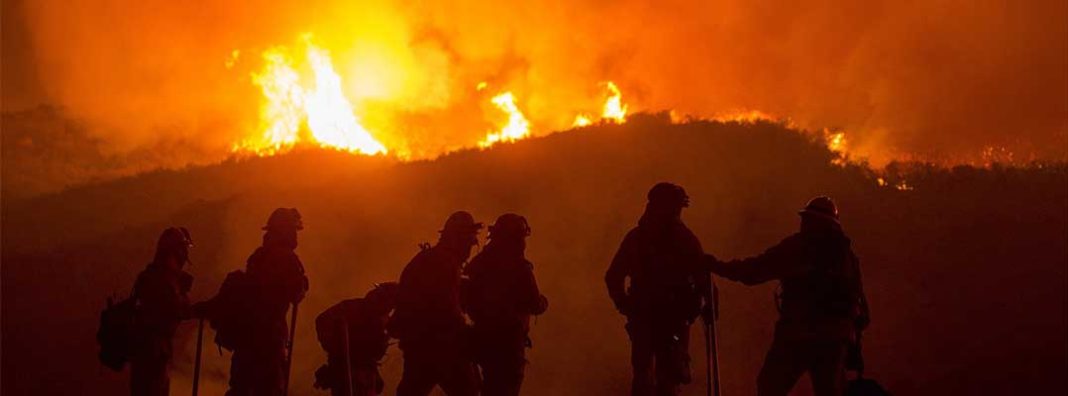
This piece is the fourth of a multi-part series by Brian Isom on wildfires. Click to read parts one, two, and three.
In January of 1969, an oil drilling accident off the coast of Santa Barbara, California, released millions of gallons of oil into the surrounding ocean ecosystem. Within days, 30 miles of beaches along the California coast were covered in oil and volunteers were working frantically to aid birds and other wildlife that had been exposed to the spill. This is often credited as the moment our modern environmental movement was born.
Barely a week before the spill, Richard Nixon was inaugurated as the 37th President of the United States. Though he is better known for other actions (including his resignation), President Nixon fought harder than probably any other previous president except perhaps Teddy Roosevelt to extend federal protections for the environment. Less than a year after the Santa Barbara oil spill, Nixon oversaw the passage of the National Environmental Policy Act (NEPA) — the first of many environmental policies that would be passed during his presidency.
In his first State of the Union address to Congress, Nixon emphasized his focus on cleaning up the environment:
The great question of the 70s is, ‘Shall we surrender to our surroundings or shall we make our peace with nature and begin to make reparations for the damage we have done to our air, to our land, and to our water?
Many of the most meaningful laws we associate with environmentalism — the Clean Water Act, the Clean Air Act, the Endangered Species Act, and even the Environmental Protection Agency — were established while Nixon was in office.
There is no question that these laws were put in place with the intention of reducing the power of individuals, corporations, or government entities to alter our natural landscapes. These landmark environmental laws aim to keep the environment pristine and unchanged. Yet the natural state of any ecosystem is constant change and adaptation, none of which can really be separated from human impact. Author Emma Marris, in her book Rambunctious Garden, emphasizes the futility of eliminating human impact on the environment:
“We are already running the whole Earth, whether we admit it or not. To run it consciously and effectively, we must admit our role and even embrace it.”
Perhaps nowhere is this more apparent than in wildfire management practices. Fighting wildfires is in and of itself a rebellion against nature, a rejection of natural forces in favor of preserving communities and valuable resources. So, while regulations allow the alteration of nature in response to threatening wildfires, they restrict those alterations when planned in advance. Unfortunately, those planned preventative alterations like controlled burns are exactly what we are currently lacking in the Western US, and what is leading to record-breaking wildfire seasons.
Although well-intentioned, environmental laws are being used to prevent any and all intentional changes to natural landscapes, meaning any proactive efforts to prepare forests for wildfires are complicated, expensive, and, in general, less likely to be accomplished.
There is a well-known saying that “the road to Hell is paved with good intentions.” Have you ever seen a wildfire? They sure look like Hell to me.
Studies on treatment efforts such as prescribed burning and mechanical thinning — the physical removal of combustible material — find that they often fall far below the desired level of actual treatment. Between 1998 and 2018, the annual number of acres burned by prescribed fires on lands managed by federal agencies made up significantly less than one percent of total lands managed by those agencies. A study in the Journal of Forestry estimates that at current rates, USFS acreage in the Sierra Nevada Mountains will have a permanent backlog of 2.9 million acres (sixty percent) in need of some form of treatment (Fig. 1).
This lack of treatment is occurring despite the fact that the USFS knows how beneficial it can be. According to Vicki Christiansen, U.S. Forest Service (USFS) Interim Chief, there have been positive results where treatments have been carried out:
We do know where we treat hazardous fuels and we go back and test if it changed fire behavior when fire came across it, 89 percent of the time it has changed the fire behavior or significantly protected critical access.
To call the USFS bad stewards of our forests, however, would not be entirely fair. They face a daunting list of challenges when it comes to preparing and responding to forest fires. There are a variety of environmental problems that the Forest Service must tackle. Expanding western populations are pushing further into fire-prone territories, increasing fire risks to lives and property, all while increasing temperatures and droughts are extending the length of fire seasons.
Then, there are also policy problems that complicate USFS’s fights against fires. Fires don’t respect the lines that divvy-up lands into federal, state, or private management. That creates a number of difficult coordination hurdles for firefighters. On top of those coordination issues, many environmental laws actually give managers more incentives to focus on putting fires out rather than preventing them from happening in the first place.
Take, for example, the Clean Air Act (CAA). The CAA and subsequent state-level policies are meant to protect the public from exposure to harmful airborne pollutants. Because controlled burns produce smoke that can have harmful health effects, controlled burns are often restricted by clean air regulation.
Ideally, no one would ever be exposed to wildfire smoke, but most people living in the west know that reality is often not so simple. For example, I live near the mountains in northern Utah and I can count on at least one or two weeks each summer of red air days due to smoke from nearby fires drifting into the valley.
Unlike smoke from controlled burns, however, smoke from wildfires is considered natural by the federal government and therefore is not regulated under the CAA. In an article for UC Berkeley’s Ecology Law Quarterly, author Kirsten Engel notes that not only does this create perverse incentives for fire managers to wait until fires start naturally, it also leads to an undervaluation of the benefits of controlled burns. Engel recommends doing away with the exemption for natural fires and adopting a “smoke is smoke” approach where incentives are offered for overall reductions in smoke levels.
This idea is further supported by a recent landmark study from the Journal of Geophysical Research. The team of researchers, who were conducting the project with support from NASA and the US Department of Energy, sampled smoke from a number of natural and prescribed burns in order to compare the amount of fine particulate matter contained therein. The more fine particulate matter present, the worse the smoke is for human health. The researchers found that smoke from naturally occurring wildfires contains more than twice as much fine particulate matter as prescribed burns. By restricting prescribed burns in favor of natural burns, the CAA may actually be exposing people to increased amounts of harmful pollution, rather than reducing their exposure.
The restrictions created by the CAA, though likely the largest hurdle to fuel treatments, are only a portion of the problem. Regulations like the National Environmental Policy Act and the Endangered Species Act further delay treatment projects and increase overall costs. Surveys of fire managers and landowners, both within and without of the USFS, find that narrow burn windows, regulations (including environmental laws), and lack of adequate personnel are the top impediments to prescribed burning. Both the burn window — duration of time during which burning is optimal and safe — and the number of personnel may be affected by environmental laws requiring lengthy assessments, such as NEPA. These assessments not only delay projects, but they increase the staff members necessary to carry out a treatment project.
If we want to return our forests to a healthy, natural state, we have to find effective ways to manage fire. Nearly a century of fire suppression has left our forests overgrown and overrun with invasive pests like bark-boring beetles. Over that same period, more and more Americans have begun to call at-risk areas home.
We can no longer afford to sit around waiting to respond to fires as they occur — as if the $3 billion-plus spent on suppression efforts last year wasn’t evidence enough. It’s time to be proactive about the way we deal with fire in this country and we can start by reforming regulations that are currently standing in the way of healthy environmental management. Giving fire managers more tools to approach fire management the way they feel is most effective will go a long way to getting us off this path of good intentions and on the road to real results.

